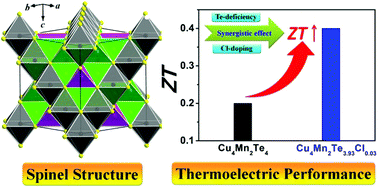Enhanced thermoelectric performance in ternary spinel Cu4Mn2Te4via the synergistic effect of tellurium deficiency and chlorine doping†
Abstract
The chemistry of copper-based chalcogenides has received considerable attention due to their diverse structures and potential applications in the area of thermoelectric (TE) materials. In this communication, a series of spinel-type Cu4Mn2Te4-based samples have been successfully prepared and their high TE performances are attributed to the enhanced power factor and low thermal conductivity via the synergistic effect of Te deficiency and Cl doping. Consequently, a maximum TE figure of merit (ZT) of ∼0.4 was achieved for the Cu4Mn2Te3.93Cl0.03 sample at 700 K, which was about 100% enhanced in comparison with the undoped Cu4Mn2Te4 sample and one of the highest ZT values reported for p-type spinel tellurides.



 Please wait while we load your content...
Please wait while we load your content...